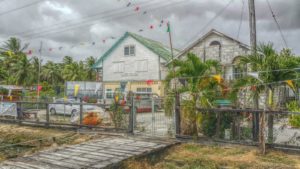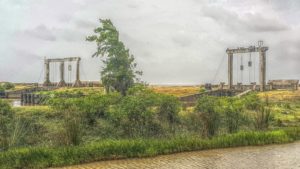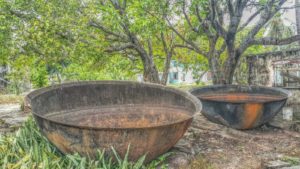By Isahak Basir, CCH
Dartmouth is a village with rich history located in Region Two on the Essequibo Coast. The glory of Dartmouth comes into brightness every Friday afternoon until Sunday night, but the ordinary traveller cannot miss this unique village of which history will not be overlooked.

From 1640 to 1850, Dartmouth has no drainage system or sea defence. The area was a “no man’s land” and was first occupied by ex-slaves who could not find solace in the existing sugar plantations. However, while the ruling plantocracy was able to enact laws restricting freed people to occupy and cultivate lands in creeks or rivers, this law was never exercised in Dartmouth. This was because of Dartmouth plot triangular shape – 800 acres of forested land – which was not in early colonial control but became a haven for people who fought against slavery.
Nearby villages, Bounty Hall and Perth, collectively, were a mathematical experiment to change the flow of canals to suit the gravity pull of the sea coast tide, which has a strange phenomenon of ebbing at low tide between the Essequibo River and the Waini River in the North West District. The British occupancy did not learn from this exercise and made a similar mistake in 1923 when they dug the Somerset Pramage canal in the opposite direction of the tide gravity pull.
In 1908 a trail was discovered through the savannah south west of Dartmouth by three land owners of charity, which was then made into a road to charity that links Pomeroon and the Northwest District.
Dartmouth is entirely agricultural where mangoes and coconuts dominate while rice, pig-rearing and other crops follow. Dartmouth was also a “rescue raft” for displeased Indian sugar workers who were unceremoniously forced to leave their logies on existing sugar estates with the collapse of indentureship. The ‘Jahangese’ renamed Dartmouth with a Hindi name “Ludge Jaa” meaning “turning back”. The remaining offspring of indentured Indians should never forget the compassion of Dartmouth.

Like a few other villages, Dartmouth has its pathfinders – the first veterinary surgeon and statesman Dr. P. A. Reid. The Andamantadors, some of whom that excelled in the medical field, include the first Regional Chairman of Region Two, Mr. Kenneth Hopkinson, who hails from Dartmouth also. Other historical families included the Brummels, Cummings, Peters, Bostons, Daymons, Gens and Persauds.
By 1961, Dartmouth landscape changed rapidly with expansions of other facilities. From 1992 there were further developments that were admirable. This village has secondary and primary schools, health centre, community building, well-paved streets, farm to the market road, modern hotel and many entertainment centres. Two main wooden public road bridges were replaced with concrete structures. With the exception of Queenstown, Dartmouth overruns the market with ‘Buxton spice’, which is the most delicious mango in Region Two.
Spokesman for the village, Carnol Daymon, a proud speaking Member of Parliament (MP), made the Neighbourhood Democratic Council office functional, new Peace Corps Volunteer tutors, a fully functioning Information and Communication Technology Computer Lab for the secondary school and also a well-kept environment.

The two concrete bridges signal Dartmouth’s presence. (Photos by Marco Basir) (Guyana Times Sunday Magazine)



